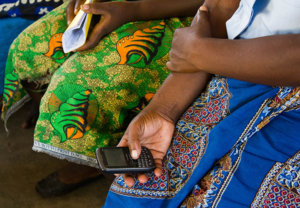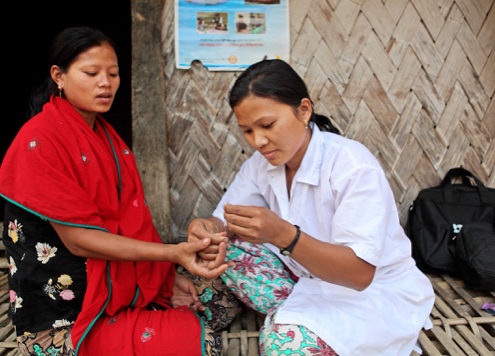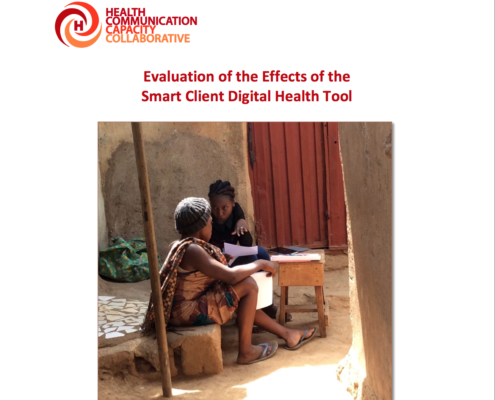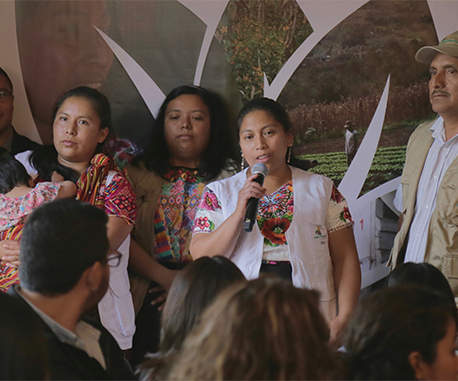Written by: Caitlin Loehr | HC3 Program Officer on April 21, 2017
“Press 1 to hear a story about a young woman who started talking with her husband to plan for their children … ”
Women and men who are interested in planning their families often go through a process of deliberation and decision-making as they choose whether to adopt family planning, what method to use, where to obtain it and whether to continue using it.
Communication is a core skill running throughout this process – communicating with one’s partner, communicating with family and friends and communicating with a health care provider. However, women and men are often not equipped with the skills they need to communicate effectively about their sexual life and body. Social and gender norms also frequently do not support engaged and empowered clients, especially female clients. As a result, female clients are often passive participants in family planning counseling, resulting in discussion and decision-making led by the provider.
One approach to building awareness and skills for active participation before, during and after a family planning counseling visit is through entertainment education (EE) and modeling of the desired behaviors. EE has been deployed in television and radio programs such as the Newman Street series in Nigeria and Bhanchhin Aama radio drama in Nepal, yet there is another channel that is still less commonly used for EE, despite its popularity and prevalence — the mobile phone.
The Health Communication Capacity Collaborative (HC3) developed the Smart Client tool to reach family planning clients directly via their mobile phone with information and skills in an entertaining and engaging format. The tool uses interactive voice response (IVR) to deliver a fictional drama, personal stories and examples of “smart client” dialogues over a series of 17 calls, along with supporting short message service (SMS) reminders. Many people are familiar with IVR from automated systems used by banks or for customer service, where you enter numbers or say aloud words or numbers to indicate your selection or information. In the developing world, IVR is often used for conducting surveys or as a “hotline,” and delivering EE via IVR is a new approach.
There are several elements making this approach unique. While the content is similar to a radio program, Smart Client tool users choose which segment they want to listen to and answer questions immediately about what they have learned, giving it a more personalized experience. Another advantage of using IVR is the built-in analytics that measure who is listening, what they are listening to, how long they are listening and the choices they are making. While TV or radio programs have to estimate exposure, with IVR, particularly the VOTO Mobile platform, it’s easy to track call logs and listening patterns. Building survey questions into calls also provides insights into the profile of the users and what they are learning. All of this real-time data is used to quickly make adaptations, rather than waiting for a separate survey to be conducted and results analyzed.
The tool is currently being tested in Nigeria and Cote d’Ivoire where it is receiving positive reviews from users:
“As married people, this story will help us in our daily life.”
“This story will help us to make decisions in the future.”
In addition to looking at what users learn from the tool, HC3 is collecting feedback on user experience since it is a new channel for EE and a new way of using IVR.
Results thus far indicate users like the content itself and that it’s delivered via their mobile phone. The biggest challenge we are noticing when monitoring listening patterns is the length of time that users are staying on the call. Perhaps the calls are coming at an inconvenient time or perhaps people do not want to spend a long time listening. Depending on the explanations given by users, the Smart Client team will make recommendations for future programs that wish to adapt and adopt the tool and approach.
Another insight gleaned through the testing process is that female users expressed interest in sharing the content with their partners. This is helpful for the development of the Smart Couple tool – an adaptation of the Smart Client tool that includes personal stories from the male perspective as well as challenges for the couples to engage in couple communication.
After testing, the Smart Client and Smart Couple tools, along with an adaptation guide, will be made available for other programs interested in using an additional channel to reach their audience and create demand for family planning services.
Listen to a “Smart Client” Dialogue
Listen to a sample of the drama:






